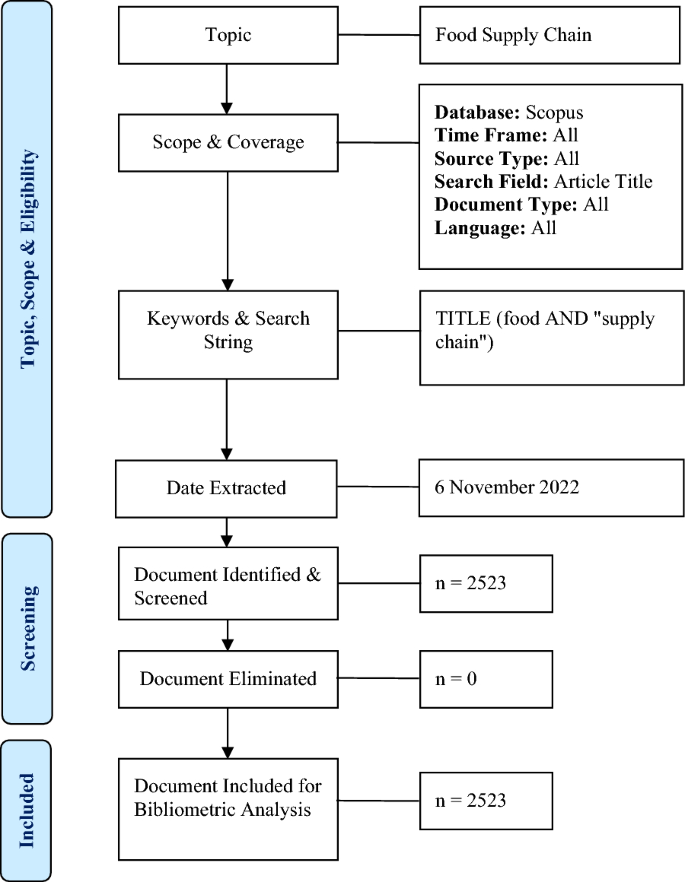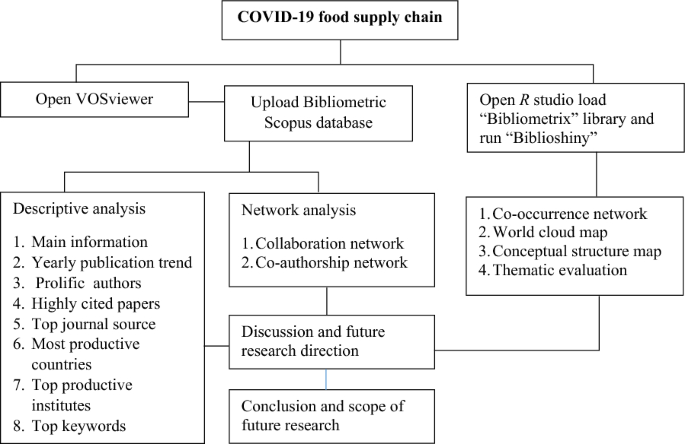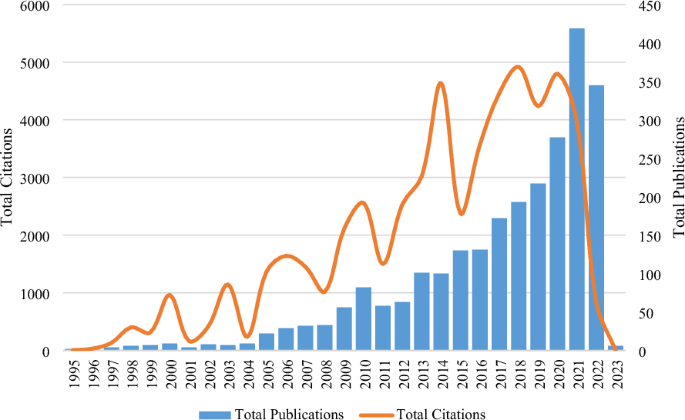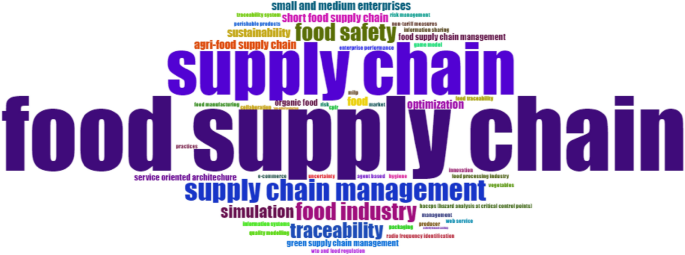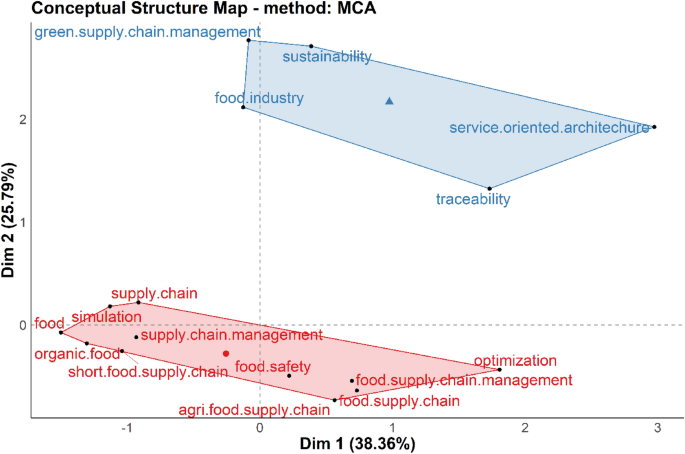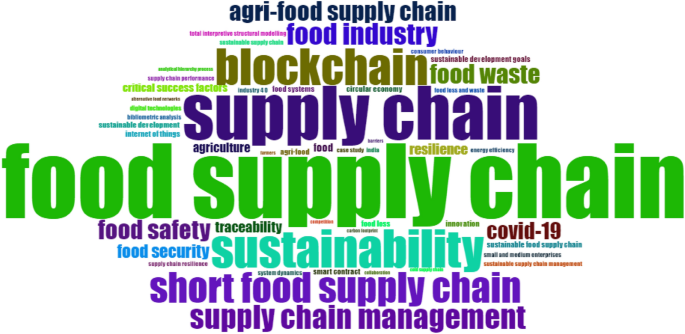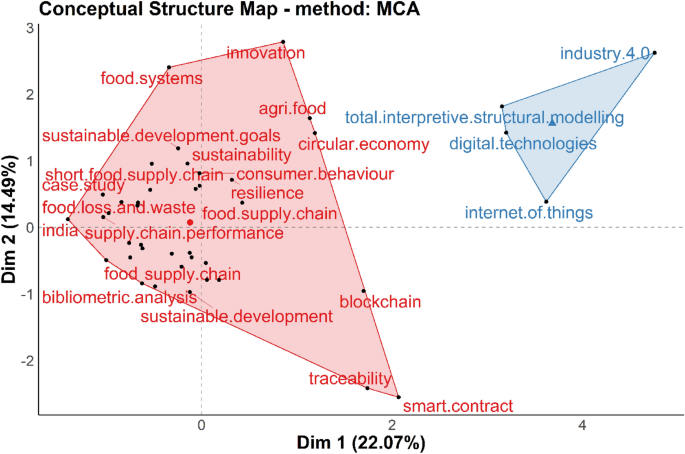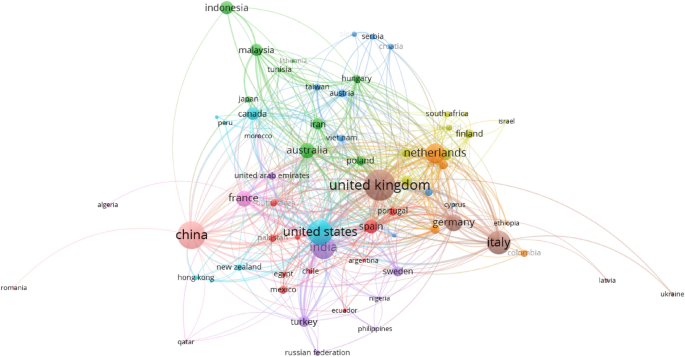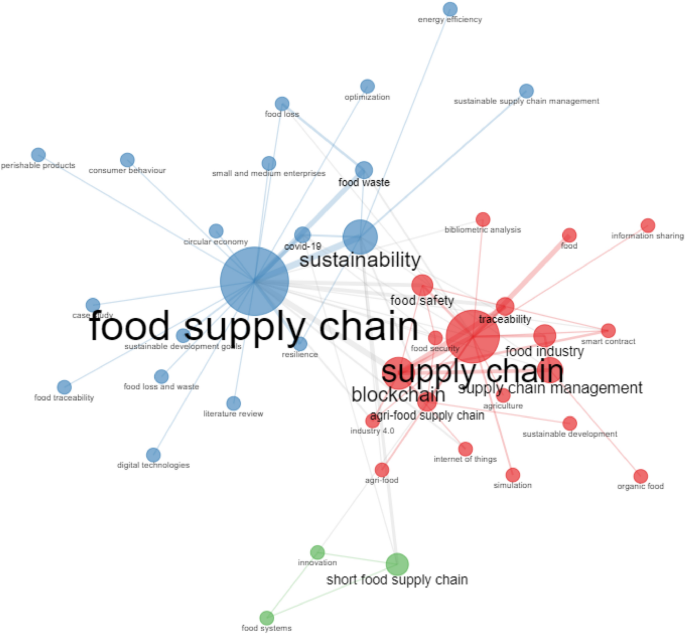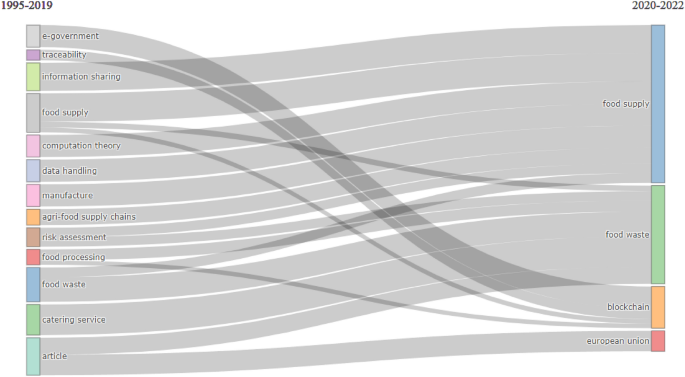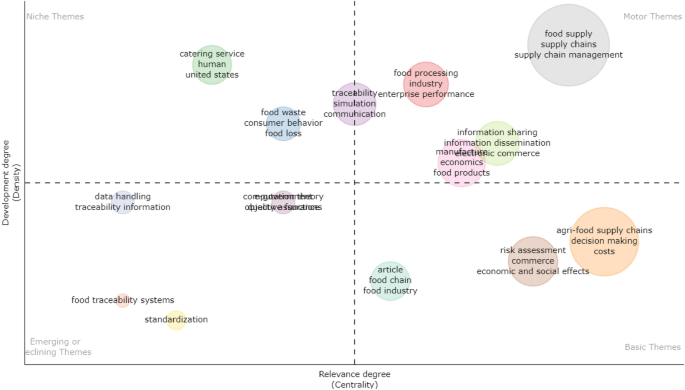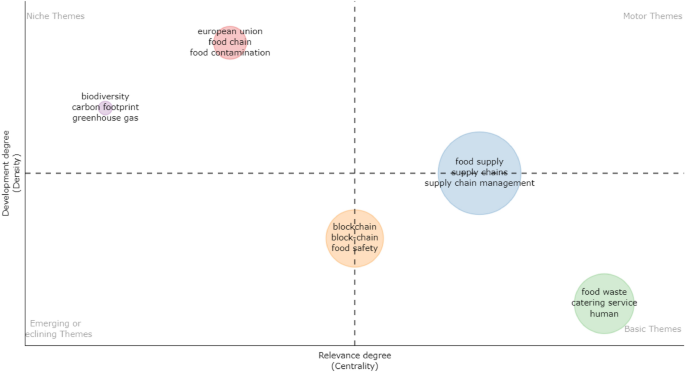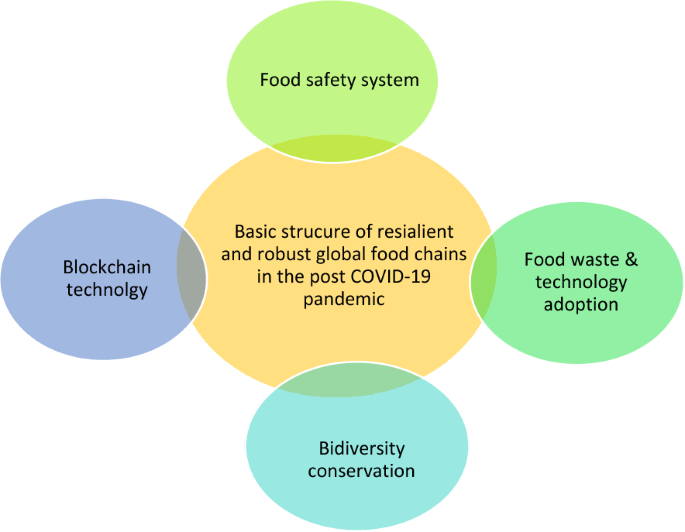- Research
- Open access
- Published:
Meta-analysis of food supply chain: pre, during and post COVID-19 pandemic
Agriculture & Food Security volume 12, Article number: 27 (2023)
Abstract
Background
Despite the unprecedented impact of COVID-19 on the food supply chain since 2020. Understanding the current trends of research and scenarios in the food supply chain is critical for developing effective strategies to address the present issue. This study aims to provide comprehensive insights into the pre, during, and post COVID-19 pandemic in the food supply chain.
Methodology
This study used the Scopus database from 1995 to November 6, 2022, to analyse the food supply chain. Bibliometric analysis was conducted using VOSviewer software to create knowledge maps and visualizations for co-occurrence, co-authorship, and country collaboration. Biblioshiny, a shiny app for the Bibliometrix R package, was then used to explore theme evaluation path maps in the research domain.
Results
The bibliometric analysis of 2523 documents provides important insights into present and future publication trends. Top author keywords included blockchain, traceability, food safety, sustainability, and supply chain management. The Sustainability (Switzerland) journal ranked first in productivity, and the International Journal of Production Economics received the highest citations. The United Kingdom was the most productive country, collaborating with partners in Europe, Asia, and North America. The Netherlands had the highest percentage of documents with international authors, while India and China had the lowest. The thematic evaluation maps revealed that articles focused on important research topics including food processing industry, information sharing, risk assessment, decision-making, biodiversity, food safety, and food waste.
Conclusion
This study contribute to the growing body of literature on the food supply chain by providing a comprehensive analysis of research trends during different phases of the pandemic. The findings can be used to inform policymakers and industry leaders about the measures required to build a more resilient and sustainable food supply chain infrastructure for the future. This study considered only Scopus online database for bibliometric analysis, which may have limited the search strategy. Future studies are encouraged to consider related published articles by linking multiple databases.
Introduction
Food supply chains are extensively explored and dependent on worldwide situations. The COVID-19 pandemic has addressed the deficiency of flexibility in food supply chain, resulting in financial and social disasters with global implications [1]. Similarly, the COVID-19 pandemic has impacted the food supply chain, from field to consumer, which represents an important sector in any country. The discriminatory nature of the pandemic had a remarkable impact on people's lives and health standards, as well as global business, supply chains, and major economies [2]. Associated restrictions imposed during the pandemic affected the food safety of household by directly disrupting the food supply chain [3, 4]. As a consequence of the severity, the stability of the food supply chain is essential to prevent interruption towards the national economy, social security and public health. Significant association of food supply chain occurred at the combination of dynamic, fragile and complicated that can simultaneously be influenced by the regulator actions, such as road closures, lockdown, and vehicle movement control. While such restrictions prevent the spread of a disease, they can also disrupt the trade of agricultural products and market chains [5]. Since the restriction was imposed by governments around the world, food distribution declined to 60% [6]. While, the COVID-19 pandemic also created serious obstruction in many sectors such as livestock production, vegetable production, plantation, cultivation and harvesting due to a shortage of labour as these sectors are comparatively labour-concentric [7]. Although, labour shortages also represented a crucial problem even before the beginning of the COVID-19 pandemic [8]. This issue is undermining the capability of farmers and agriculture enterprises to operate because of scarcity of workers owing to illness and physical distance during harvesting. These circumstances delayed the provision of food and agriculture input and integrated issues in the food supply chain to market [9]. However, several firms depend on their key inputs, whereby the maximum are more vulnerable to disruptions since domestic markets have to meet their requirements. Barriers to logistics which interfere food supply chain further weaken high-value commodities because of their limited shelf life [6, 10]. Therefore, maintenance of logistical efficiency, particularly during and after the global crisis is a vital aspect of the food sector. Correspondingly, raw material procurement from suppliers is the biggest bottleneck in the food supply chain and ensuring a continuous flow of food from producers to end users [11]. The challenge is to risk the capacity of agriculture producers to operate as usual which can negatively affect freshness and food safety, food quality, and limit market entrance and pricing [10]. The effects on agricultural systems due to the pandemic depend heavily on the composition and intensity of agricultural activity and vary according to the product manufactured and the country. In low-income countries, productivity is mostly labour oriented, whereas, in high-income countries, capital-intensive practices are generally dependent on agricultural production. Therefore, the supply chain should remain operational with a focus on crucial logistical problems [6]. In addition, the supply chain involves not just producers, distributors and customers, but also labour concerted food processing plants. Production in several plants has been limited, interrupted or temporarily stopped owing to workers who have been identified COVID -19 positive and who have hesitated to go to work presuming they are sick, especially in meeting processing firms at the time of the pandemic outbreak [12, 13]. Besides, another important factor that caused food supply chin disruption during COVID -19 pandemic is centralized food production. This approach has contributed to the production and cost reduction of food processors. Centralisation has some limitation such as inflexible and long supply chain problems. Furthermore, it might cause challenges to meet demand through a small numbers of very big production facilities [14] such as closing the full process if a pandemic leads to high volume production lines with less options. In the face of these problems, food supply chain have shown tolerable resilience while supermarket shelves were refilled with the disappearance of hoarding behaviour and the demand growth response to supply chains [15].
Although several articles were published and included the aspect of COVID -19 impact on the food supply chain but are primarily concerned with the focus on the subject. Direct studies were related to bibliometric analysis to know the trend and scenario of research were not known. Thus, it is crucial to provide information with a clear direction of the present research status and future trends in the COVID-19 food supply chain. Evidence from several cohort studies in the bibliometric analysis was conducted on food safety governance [16], food supply chain safety research [17], and agri-food value chain [18]. As far as we know, there are no bibliometric analyses conducted related to COVID-19 food supply chain pre, during and post-pandemic.
After identifying this gap, this study tries to fill the gap by developing a detailed analysis of COVID-19 food supply chain studies pre, during and post-pandemic. As a quantitative analysis method, a bibliometric technique is adopted to develop a trend in various domains and utilized to uncover the present status [19,20,21]. In bibliometric analysis, researchers can define fields of research, looking at the further direction of research, and getting involved with other institutes and countries [22]. Hence, this study specifically focused to answer the pertaining research questions to present the trend of the previous studies on COVID-19 and the food supply chain with the global development of the field.
-
1.
What are the dynamics and trends of COVID-19 food supply chain literature?
-
2.
What are the highly-cited documents in COVID-19 food supply chain research through time?
-
3.
What are the most productive authors, countries, institutions, and source titles in terms of publication numbers?
-
4.
What are the more productive keywords in the COVID-19 supply chain research pre, during and post-pandemic?
-
5.
What is the current knowledge formation status relating to co-occurrence, collaboration and co-authorship linkage in COVID-19 food supply chain research?
-
6.
Which are the most productive research themes, and how did they evolve through time?
This study adopted a bibliometric technique to analyse the publication of COVID-19 on food supply chain research extracted from the Scopus database to provide a functional overview of the current trend of predictable research throughout the world. Scopus is considered the largest cited and referenced abstract of literature containing a wide range of subject areas. Employing Scopus is, therefore, an attempt to comprise more subjects which are not explored in WoS [23, 24]. This study will help researchers, policymakers and individuals to support food supply chain research trends and to explore the possibilities and opportunities for future study.
To answer the research questions, the paper is organized into the following sections. “Introduction” Section discusses a brief introduction to the topic including the current knowledge on the impact of COVID-19 on the food supply chain, the research gap, and the purpose of the study. “Literature review” Section discusses the literature review in the field of the COVID-19 food supply chain in general. “Bibliometric analysis and methods” Section describes the methodology used in this study which includes Bibliometric, Biblioshiny, and presents the flowchart and data analysis structure. “Results” Section covers the discussion to answer the above research questions and future research directions. “Conclusion” Section describes the conclusion that covers the contributions, limitations and future research scopes.
Literature review
The COVID-19 pandemic triggered disruptions to the food supply chains which included purchaser concern buying attitude for key items, as well as a rapid change in consumption trends, which shifts away from the food service industry and toward meals ready and consumed at home [25]. A similar study was focused on the supply chain and the food industry is no exception. Due to a decrease in demand, the closure of food production services, and financial constrain, the businesses are unable to continue supplying their products to stores[26], and the current status of the COVID-19 pandemic has put unprecedented pressure on food supply chains. These include bottlenecks in transportation, logistics, farm labour, and food processing [15]. This behaviour of the food supply chain (FSC) is identified a main reason worldwide [27]. The scenario is that the food supply chain is disrupted with a potential breakdown in food freight borders, increasing business flexibility and social capital through real-time business communication [28]. Because of emerging COVID-19 pandemic issues, there are major concerns about food production, manufacture, delivery, and consumption in the food supply chain [2]. Therefore, a lack of consumer access to food poses the ultimate threat to food security. There is also a massive rise in global food issue with the appearance of COVID-19 and the advent of numerous difficulties in all sectors of the food supply chain (such as production, distribution, and transportation), and this problem has taken on added significance [29].
COVID-19 pandemic has had a significant effect on the global food supply chain, raising public awareness about the constancy of the global food network and the significant interruption to food availability [30]. It is proven the COVID-19 pandemic has an effect on the agricultural and food supply chain from two angles, which are "food supply and food demand" [31, 32]. In current months, the COVID -19 pandemic had threaten the global food supply chain creating economic instability, constraints to food accessibility, restrictions on farm commodity shipping, limitations on food production, difficulties in food product transit, evolving consumer demand, food production facility closures, shortages of farm workers to harvest vegetables, farm worker travel restrictions, and fruit deficiencies [33,35,35]. Therefore, numerous countries adopted diverse strategies to reduce the impact of COVID -19 on the food supply chain [34]. However, a potential problem still exists that need to be addressed to gradually resolve the present crisis. Hence, the global food supply chain is facing many issues resulting from the continuing COVID-19 pandemic around the world, which has prompted serious issues about food supply, distribution, processing, and demand [35]. Accordingly, the COVID -19 pandemic has increased disruption and damage to the global food supply chain in the following areas, which are (i) logistics (ii) harvest (iii) processing (iv) sourcing, and (v) go-to-market [36].
Bibliometric analysis and methods
Bibliometric analysis
Bibliometric studies provide a wide range of options for understanding the significance of all studies. A quantitative and qualitative technique of bibliometric analysis is used for the publication of journals and articles, including their corresponding citations over time [37]. It differentiates the present status of research by measuring the scientific outcome of a country and institution and has played a major role in the past in influencing policymaking and improving the knowledge of science [38, 39]. This also allows researchers to identify and help them to determine the scope of study topics, and plan their focused mind and projection of trends [40]. This method can provide a statistical output for calculating and estimating the number and development trends of a particular field [41, 42]. Several studies have explored the food supply chain using the bibliometric technique [43,45,45]. This research provides a quantitative literature review by drawing connections between various keywords related to the food supply chain. It is a standardized technique for calculating and assessing written communication among authors [46], quantifying the trend and characteristics of a certain research area based on several measures [47, 48], and focusing on research titles, keywords, affiliations, authors, and article publication [49, 50], network and countries [51], co-authorship links, co-citation links, bibliographic coupling links that may be used in citation mapping to visualize a cluster or theme [51], and supply chain management [52]. In this study, Scopus databases are considered to extract necessary information. It is chosen as the source of the largest abstract indexing database and it is recommended by the previous studies that would cover a wide range of areas and provide comprehensive search options to help researchers develop search strings with accurate results, especially in broad areas of the research [44, 53].
Thematic evaluation
Thematic evolution is a new research technique that is currently the widest accepted method for using many disciplines to measure the topic growth, evolution, and flow of a specific research area over time, supporting scholars in understanding the growth of a particular research area more methodically. This study used Biblioshiny, a shiny application for the Bibliometrix R package, to performthe thematic evaluation mapping [38, 54]. To analyze the evaluation theme, the proportion of total authors' keywords indicated by drawing the range of the subject direction on the coordinate axis. The growth and decrease of the alluvial area represent the change in scale over time.
Method
Data collection
This study has chosen the online Scopus database from 1995 to 6 November 2022 in food supply chain because it is the world's largest citation and abstract database of scholarly works from international publishers which provides a one-stop platform for scientific scholars [55]. Especially, compared to other databases like Web of Science (WoS), Google Scholar (GS), and PubMed (PubMed), Scopus has a wider variety of publications and helps with both keyword searches and bibliographic analysis [56]. Scopus has 20% higher coverage than WoS in terms of citation analysis, however, Google Scholar produces inconsistent results. PubMed is a database that is commonly utilised in scientific research [56]. Figure 1 shows the search strategy and detailed steps for the data collection for this study.
Search strategy
In a bibliometric study, it is important to choose the appropriate keywords. Based on the research questions, this study limited the search to two main title keywords: “food” and “supply chain”. Therefore, this research encompassed two possible combination strings of keywords that are relevant to the study’s topic. The title of an article should incorporate information that can be used to capture the attention of readers since it is the first element that readers will observe first [57]. Finally, this study comprises two search query strings TITLE (“food”) AND TITLE (“supply chain”). A total of 2523 research documents between 1995 and 6 November 2022 were obtained from the Scopus database (Additional file 1). There were no excluded methods applied during the search of the document as shown in Fig. 1.
Tools and data analysis
Numerous disciplines had adopted VOSviewer to perform bibliometric analysis, e.g., social media in knowledge management [58], supply chain and logistics [59], presumption [58], business intelligence [60], health [61], and brand personality analysis [62]. To achieve the research objectives and research questions, this study adopted VOSviewer software to visualize the geographical distribution, authorship, citations, keywords, collaboration among countries specifically on COVID-19 food supply chain topics. The VOSviewer visualises bibliometric maps in different methods to present various features of literature structure. The VOSviewer employs an integrated approach to mapping and clustering that is constructed on the normalised term co-occurrence matrix and a similarity measure that determines the intensity of association between terms [51, 63]. Based on citations and bibliographic coupling links, the VOSviewer creates clusters of authors' keywords, countries, and organizations. These clusters indicate the compactness of articles, keywords, countries, and organizations in specific research. In addition, Microsoft Excel 2013 software tools were used to analyze the primary data collected from Scopus (CSV format). Finally, R studio explores the evolutionary themes of COVID-19 food supply chain research topics pre, during and post-pandemic. Figure 2 portrays the different steps and analyses performed in this study. To address the research questions, the study is divided into two parts: descriptive analysis and network analysis.
Results
Descriptive analysis
This section explores the COVID-19 food supply chain research profile from 1995 to 2022, these include all current publication information, research trends, prolific authors, highly cited papers, publication sources, most productive institutions and countries, and the authors’ keywords as shown in Table 1.
Yearly publication trend
The total publication, total citation, citation per article, and citation per year of the articles published between 1995 and 2022 were used to analyzed the yearly publication trends. Table 2 and Fig. 3 describe the yearly publication trend on the food supply chain pre, during and post COVID-19. In general, the number of publications on the COVID-19 food supply chain significantly increased from 217 articles in 2019 to 419 articles in 2021. The rate of development after 2020 was rather drastic and the number of publications increased to almost double that of the previous year. The growth of published articles indicates that the topic is beginning a stage of development. As a result, as of November 2022, 345 articles were published that have undertaken and explored new related topics attributed to the worldwide pandemic issues which simultaneously disrupted the supply chain.
Most productive authors
The number of total publications, total citations, and h- index are analyzed to understand the most influential authors in COVID-19 food supply chain research domain. There are 5839 single authors devoting to food supply chain research from 1995 to 2022. Table 3 shows the twenty most prolific authors and found that Van Der Vorst, J.G.A.J has received the highest number of publications at 26 publications, 1945 total citations and h- index of 18 in this domain. Results revealed that Kumar, A. and Li, D are among the most prominent authors in the COVID-19 food supply chain field.
Highly cited papers
Table 4 shows associated information (authors, article title, total citations, and citations per year) of the top 20 most productive journals. The paper titled “Food waste within food supply chains: Quantification and potential for change to 2050” had 1699 total citations and 141.58 citations per year, followed by “Understanding alternative food networks: Exploring the role of short food supply chains in rural development” with a total citation of 1033 and 54.37 citations per year, and “An agri-food supply chain traceability system for China based on RFID & blockchain technology” had a total citation of 751 and 125.17 citations per year, respectively. In addition, the core journals in COVID-19 food supply chain studies are multidisciplinary, referring to traceability, corporate social responsibilities, modelling approach, sustainability, bioavailability and human health, blockchain technology, fresh food quality etc.
Most productive source titles
There are 2523 articles published in different journals. Table 5 shows the top twenty source titles that published ten or more documents from 1995 to 2022. Sustainability (Switzerland), Journal of Cleaner Production and British Food Journal are the top three publishers with a total publication of 102, 67, and 52 on the COVID -19 food supply chain and total citations of 1571, 2669 and 1394, respectively.
Most productive countries
According to the Scopus database, COVID-19 food supply chain documents were extracted from 127 countries. Table 6 shows the top thirty most prolific countries with at least 25 papers published. Among the highest thirty countries, the United Kingdom is the most productive country with a leading publication of 400 articles, accounting for 15.85% followed by China with 327 articles (12.96%) ranked the second position, United States ranks third with 272 articles (10.78%), Italy ranks fourth with 234 articles (9.27%) and India ranks fifth with 230 articles (9.12%), respectively. As indicated, these productive countries have a greater concern about COVID-19 food supply chain research pre, during and post-pandemic than other countries.
Most prolific institutions
Table 7 lists the top ten most prolific institutions for the 327 articles studied accounting for 12.95% of total documents relating to COVID–19 food supply chain research. Wageningen University & amp; Research, Alma Mater Studiorum Università di Bologna and Cranfield University are the core contributor to this research domain. These institutes have published 183 articles, which interprets for 7.27% of the entire publications. The results indicate that the productive documents are extremely intense among a few institutes only.
Top frequent authors’ keywords
Table 8 presents the top frequently used authors' keywords in the food supply chain before the COVID-19 pandemic. There are 34 occurrences of the food supply chain put in the first place, followed by 24 and 10 occurrences in supply chain and supply chain management, respectively.
In bibliometric analysis, a word cloud of author's keywords is a visual representation of the most commonly used words in an article's list of keywords to identify the most common themes in an author's work. The size of each word in the cloud represents its frequency in the list of keywords [84]. Figure 4 shows the word cloud map of the top author’s keywords before the COVID-19 pandemic. In the map, cloud-found food supply chain, supply chain, supply chain management, food industry, food safety, and traceability are the always core analyse research topics. Based on this analysis, it was found that a relationship was established linking food safety, agri-food supply chain and sustainability. This proves the importance of research in linking these three keywords and their impact on the COVID-19 food supply chain are interconnected.
In addition, this study used Multiple Correspondence Analysis (MCA) with the R package bibliometrix to investigate the author's keywords. The MCA is a data analysis method that could be applied to the graphical analysis of categorical data [38]. This study chose MCA because this analysis can identify the underlying themes established on the author’s keywords. Using the MCA method, related keywords are grouped, providing a hierarchical display of how frequently used terms are typically employed [83]. If two separate terms (like food and supply chain) appear in the same number of articles, then the two terms can be grouped [38].
Figure 5 maps the authors’ keywords conceptual structure associated with the “food” and “supply chain” publications domain before the COVID-19 pandemic. This map shows that the publications included in the analysis are categorized into two major groups which are red and blue. In each group, some words are connected. The red cluster shows more different words to which many research publications connect the words organized in this field. The conceptual structure is appeared in the keyword ‘co-occurrence’. For the red cluster, food is linked to food safety, organic food, short food supply, agri-food supply chain, and supply chain management. For the blue cluster, the supply chain is linked to food industry, sustainability, green supply chain management. Future research focuses on service oriented architecture and traceability, which follow the food supply chain stability to protect the disruption.
Table 9 shows the most commonly used author’s keywords in food supply chain after COVID-19. Food supply chain appeared is in first place with 61 occurrences, followed by the supply chain, and sustainability with 44 and 31 occurrences, respectively. Following Fig. 6, Table 9 indicates the top ranked keywords based on their co-occurrence.
Figure 6 shows the word cloud map of the author’s keywords after COVID-19 pandemic. Among the top word, cloud focused food supply chain, supply chain, blockchain, sustainability, short food supply chain, supply chain management, food industry, and agri-food supply chain are the core analyse research topics. Based on this analysis, it was found that a relationship has been established linking food safety, food security, food waste, traceability, and resilience. These top words are not expected and not to consider the searching string. However, these associations clearly indicated that there are severe influences on food supply chain as a whole after COVID-19 pandemic.
Figure 7 presents the author’s keywords conceptual structure involved with the food supply chain research domain after COVID-19 pandemic. The figure explores that the publications evolved in the analysis are clustered into two key groups, which directs the logical construct of food supply chain studies. For the red group, food is linked to food system, food loss and waste, short food supply chain, and food supply chain performance. For the blue group, supply chain is linked to total interpretative structuring modelling, digital technology and internet of things. Future research focuses on food supply chain study related to blockchain, traceability, resilience, innovation, sustainable development, consumer behaviour and crucial economy, which is the way of comprehensive understanding of food supply chain research trends.
Based on the analysis of word clouds and conceptual structure maps, it has been found that certain words may appear frequently in a word cloud of an author's keywords but not be represented in the author's conceptual structure of keywords. This is because a word cloud simply represents the frequency of occurrence of individual words or phrases, while an author's keywords conceptual structure focuses on the relationships between those words and phrases. For example, a word like "food industry” may appear frequently in an author's list of keywords and thus have a comparatively large size in the word cloud, but it may not be a central concept in the author's research, and therefore may not have a visible position in the author's keywords conceptual structure. On the other hand, a less frequently occurring word like "consumer behaviour” may have a more central position in the author's conceptual structure, even though it appears less frequently in the word cloud. Overall, both tools serve different purposes in bibliometric analysis and provide complementary insights into an author's research focus [50].
Bibliometric mapping analysis of COVID-19 food supply chain
A common application of bibliometric mapping analysis is to recognize particular research fields to gain an outline of the topology of the study area, its themes, topics, and terms, and how they connect closely [85]. Furthermore, to visualise the output of bibliometric mapping, a worldwide mapping analysis method is visualization of similarities (VOS) [46, 51, 83] has been adopted through a computer aided program called VOSviewer (Leiden University, Netherlands) [63]. The VOSviewer visualizes bibliometric maps in a range of methods in accordance with emphasising unique factors regarding the literature production. VOSviewer applied a combined method for both clustering and mapping or it is mainly created on the standardised term co-occurrence which estimates relationship strength between terms and is also an effective tool for conducting network analysis [86]. Furthermore, VOSviewer Version 1.6.2 [63] allows the construction of sceneries in which terms are coloured based on the year of their first presence in scientific publication. The size of the font and the enclosing rectangle indicates the popularity of a term; bigger rectangles and fonts indicate more productive terms. This study used VOSviewer to visualise co-authorship and collaboration networks and R studio to visualise co-occurrence of keywords and thematic evaluation of COVID-19 food supply chain topics.
Co-authorship analysis
Co-authorship network visualisation revealed knowledge domain maps of major authors groups in the COVID-19 food supply chain research. Figure 8, each node shows an author, and the size of the nodes indicates the number of published articles. The link connecting two nodes represents the collaborative relationship between two authors, and the thickness of the link indicates the degree of association. Based on the knowledge domain maps of the co-authorship network, potential authors can deliver important information for a research institute to improve collaboration groups, for individual researchers to seek collaboration scopes and for the publisher to gather editorial teams to publish special issues in journals or books. It can be seen from Fig. 8, the cooperation among prolific authors is intense. Co-authorship network formed several groups, such as the yellow group comprising Van Der Vorst (documents 26, links 26), followed by Kumar (documents 19, links 36) in the green group, and Liu (documents 16, links 16) in the yellow group as the core. Based on the results among the research groups, most productive authors mainly work independent or in collaboration inside the same organization, but the scale of such collaboration is small and not firm resulting to a lack of effective international exchange and cooperation.
Countries collaboration network
This study established a collaboration network among countries through VOSviewer software in the research domain knowledge map in the field of COVID-19 on the food supply chain. A network visualisation map is presented in Fig. 9. The co-authorship collaboration was established among 127 countries whereas articles were contributed from 67 countries (minimum threshold document 5). The thickness of the line indicates with each country can be determined by the frequency of co-authorship. This map indicates that a satisfactory collaboration network was established between the United Kingdom, China, United States, Italy, India, Netherlands, Germany, and France. More importantly, the United Kingdom collaboration developed with the European, Asian and North American countries and received the highest citations of 14712, links 301 and 400 documents. However, Singapore, Peru, Israil, Algeria, Romania, Lativia, Ukraine and Qatar have had less cooperation with other countries. In our opinion, there are two significances of the high proportion of articles in countries. First, it contributes to the delivery of more detailed study topics, and secondly, provides a window of opportunity for the collaboration of new countries; in other words, it enables the collaboration of other researchers and institutions in these fields.
Keyword co-occurrence network
Keywords are the major content of publications, and the purpose of keyword analysis is to identify important research compositions in COVID-19 food supply chain. A co-occurrence network of author’s keywords was used to highlight research topics in the field. The method refers to the most commonly used keywords represented by the font size and larger circles [61]. The lines between the keywords reflect their correlation strength [20, 61]. For a better understanding, the related keywords are commonly listed, as indicated by the same colour. Keywords without lines between them indicate that no connection has been developed. Considering that the closer to the centre of the network map terms appear, the more co-occurrence together. A closer connection indicates a stronger association.
To explore associated keywords to COVID-19 food supply chain research, the results in Fig. 10 indicate that two thematic clusters have been identified such as (i) food supply chain, and (ii) Supply chain and each cluster is denoted in a different colour. As shown in Fig. 10, food supply chain covers the network centre, demonstrated by the greater cluster theme studied by previous scholars. The keyword ‘food supply chain’ is superposed on sustainability, food waste, COVID-19, circular economy, resilience, small and medium enterprise and food loose representing the closeness between them, further, COVID-19 impact on the food supply chain cannot be separated. Though in the second network of the supply chain, the linked keywords are supply chain management, blockchain, food industry, traceability, food safety, agri-food supply chain and short food supply chain. These highlight the COVID-19 pandemic impact and implies the rising attraction in this research field.
Thematic evaluation
This study used Biblioshiny software to analyse the author's keywords pre, during and post-COVID-19 food supply chain research to draw the evaluation of core research themes from 1995 to 2022. Figure 11 shows a Sankey diagram to analyse the journal's thematic evolution for the readers related to COVID-19 food supply chain. A Sankey diagram is used to demonstrate how various themes are related and have evolved in the past [54]. Each box on the map represents a theme, and the size of the boxes is relational to the frequency with which the theme occurs [87]. The flows connect each box, displaying the theme's evolution traces, and the thicker the connecting line, the stronger the link between the two themes. Overall, themes in COVID-19 supply chain are becoming more diverse over time, probably because more scholars from various fields are attracted to this theme. These indicated that the COVID-19 food supply chain gradually intersects with various fields such as e-government, traceability, information sharing, risk assessment, food waste, and blockchain. As shown in Fig. 11, COVID-19 research in the food supply chain has evolved into six new themes from 1995 to 2019 and three themes from 2020 to 2022. Furthermore, it shows how the six themes exhibited with three themes before and after the COVID-19 pandemic.
While Fig. 12 shows the thematic map before the COVID-19 pandemic mainly the upper-right quadrant reveals the motor theme which is high centrality and density because these themes are well developed and significant to the structure of a research field. The lower-right quadrant shows the basic themes. They are categorized by moderate centrality, which is resilience and the main focus in COVID-19 food supply chain research. This quadrant consists both transversal and general themes. The upper-left quadrant shows the niche themes which are strongly interconnected among themselves and have strong centrality to outside research. These concerns are extremely broader and significant. The theme related in the lower-left shows the growing or decreasing themes which are minimal and underdeveloped. The themes in this quadrant have a low density and centrality and they commonly reveal new theme.
Figure 13 provides an overview and future trends of academic research on the food supply chain after the COVID-19 pandemic through the themes presented in the four quadrants. The motor themes have been developed extensively in both food supply and supply chain management. Food waste and catering services are well developed and isolated, and they occupy the basic theme. This is practically after COVID-19 pandemic, these themes gained importance for the food supply chain. Relatively emerging theme have currently been discussed comprehensively the subject of blockchain and food safety included in the third quadrant of cointegration has been on the boundary between basic and emerging themes, which is high centrality and density to the structure of a research field. Finally, the fourth quadrant is the food chain and food contamination themes are relatively wider and have a strong connection with the food supply chain. The most important rising topics in this period were the blockchain and food safety, which is on the border between basic and emerging or declining themes. Strongly interconnected niche theme is food contamination as a new problem in the food supply chain.
Discussion and future research direction
The descriptive analysis simplifies the present trend of research on the food supply chain by analysing pre, before and -post-COVID-19 data. It shows growing interest in COVID-19 on the food supply chain from the scientific community, which is an attractive issue in research, with a significant publication. Still, the COVID-19 pandemic led to high incidents in the food supply chain and the investigation and development strategies might be the result of this interest. It is proven that the current trend of COVID-19 impact is a major challenge to food supply chain analysis research and the pertaining term in the food supply chain has been encouraged in terms of COVID-19 impact reduction. By analysing the top keywords, many prospects for future study that have been disclosed by the COVID-19 pandemic. The COVID-19 has exposed supply chain vulnerability, confirming the importance of optimization and simulation. Implementing new technologies can improve efficiency, save costs, and increase customer satisfaction, allowing businesses to remain competitive. Similarly, Keywords on short food supply address these difficulties, there may be a shift towards shorter, more localized food supply chains can improve resilience and reduce the risk of disruptions caused by global crises or natural disasters. This approach may also provide potential synergy between sustainability practices and the need for more robust and sustainable food supply systems [88, 89]. The use of blockchain technology can enhance traceability in supply chains, reducing the risk of food fraud and improving food safety. Blockchain can also support the adoption of sustainable and effective supply chain management strategies, particularly for short food supply chains. However, further research is necessary to develop new models for direct sales and blockchain-based systems that can validate the sustainability of food products. To minimize waste and increase efficiency, it is essential to integrate blockchain technology into food supply chains in a way that considers both economic and environmental impacts [91]. Finally, the Covid-19 outbreak has emphasized the significance of collaboration and innovation in the food industry. In the coming years, there may be a surge in investments in research and development, along with increased partnerships between industry players to discover new ways to address the issues affecting the food sector. Through these efforts, the industry can build a more resilient, sustainable, and secure food system for the future [92]. This also might lead to different directions for research, which include exploring new related topics and exploring less studied fields through a new framework. It might also be beneficial to provide new collaboration opportunities to widen the scope of the study.
Then, this study found the most productive countries, institutes and productive authors. The results explored that the United Kingdom is the most emerging country, but at the growing stages, China, the United States and Italy are also effective contributors in this field. The Wageningen University & amp; Research and Alma Mater Studiorum Università di Bologna have been the most productive institutes with one hundred twenty (120) and thirty-three (33) publications. Looking at the prolific authors, Van Der Vorst received the highest citation with 1945 citations. These countries and institutions have produced more in-depth and critical research in this area. The results of this analysis help governments, institutions, and authors work together, share knowledge of the COVID -19 food supply chain, and employing comprehensive strategies and efficient methods to address supply chain-related issues.
To develop an in-depth understanding of the results, this study used bibliometric mapping to provide a more comprehensive visualization of the results. The author’s keywords and co-occurrence (or co-word) analysis demonstrated that more research was focused on COVID-19 food supply chain and its impact on food security, food safety, traceability, food industry and sustainability which is closer to the circle. This finding addresses the issue of the COVID-19 food supply chain is linked to agriculture production and policy for food sustainability and its outcome is rational on the implication of food safety and food security to protect regular demand [87, 88]. Another important issue suggests that creating more supply chain resilience may initiate a better initiative to managing and reducing challenges and risks faced pre and post COVID-19 pandemic [89, 90]. Meanwhile, the co-authorship network shows that comparatively less collaboration occurs among authors on COVID-19 food supply chain research. This implies that the findings of Van Der Vorst and Kumar play an important role in the collaboration network. Although having a low level of relationship act as knowledge breakers among groups. The findings of the study also show that Li, D. Manning, L. and Accorsi, R have the same number of publications but few relational ties. This outcome could be influenced by limited collaborations within a closed group. Therefore, effective collaboration among scholars is required to widen the scope of COVID-19 food supply chain research.
By analysing thematic evaluation using the author’s keywords and compiling the results that postulate further direction that the research prolific topics of COVID-19 food supply chain are mainly connected to the food processing industry, traceability enterprise performance, information sharing and dissemination, decision making, risk assessment, food waste, food loose, and food traceability system. These eight primary directions are captured with each other in the evolutionary process. Research on the COVID-19 food supply chain still has significant potential for development because the integration, intensity, and reorganization of themes are more pronounced, showing that the articles are closely related and the degree of diversity is not high. This interdisciplinary research indicates that the COVID -19 food supply chain has an impact on food security and triggered disruption to respond to the current pandemic food security and caused disruption to food supply chain and suggests developing a framework for smooth resilience in the food supply chain system [33].
Furthermore, this study develops a basic structure for the most affected themes within the global food chain created by the post-COVID-19 pandemic. Generally, the global food chain combines production, processing, distribution, and consumption on a large scale [15, 92]. The intensity of the impact may vary among sectors and goods at various stages of the supply chain for various products. There are four significant issues raised in the thematic analysis that the global food chain should address in the post-COVID-19 pandemic. The following diagram (Fig. 14) presents the basic structure of the global food chain that can help the food industry adapt to the post-pandemic situations caused by COVID-19.
Firstly, COVID-19 has highlighted the crucial importance of food safety in the global food chain. Ensuring safe food from farm to fork is now a top priority for governments, food manufacturers, and consumers worldwide. Therefore a robust food safety system (e.g., processing, distribution and preparation activities, consumption, and delivery) and a strong food safety culture would safeguard public health and prevent future pandemics [93]. Secondly, COVID-19 disruptions in transportation, distribution, and consumption have led to increased food waste, resulting in significant losses in food supply chains. These relevancy have encouraged the implementation of Industry 4.0 technologies and practices, aimed at addressing the widely recognized issue of food waste and loss. Specifically, advanced technologies such as Internet of Things (IoT) platforms, BIG Data, artificial intelligence, and information and communication technologies (ICTs) can be leveraged to obtain up-to-date information, enhance communication between suppliers and buyers, and rationalise the distribution of food supply chain [90]. Thirdly, the COVID-19 pandemic has disrupted the food supply chain, raising concerns about the need for increased transparency, efficiency, and safety in the food industry. Consequently, there is a growing interest in employing blockchain technology to resolve these issues. Blockchain provides a secure and transparent way to monitor food products from the farm to the table, thereby reducing food waste and ensuring food safety and quality. With its potential to improve supply chain management and food safety, blockchain is anticipated to play a crucial role in the post-COVID-19 pandemic food industry [94]. Fourthly, the COVID-19 pandemic has resulted in an increase in pressure on natural resources and a decline in biodiversity. The post-COVID-19 pandemic presents an opportunity to construct more resilient and sustainable food systems that promote both human welfare and biodiversity conservation. By creating a secure and transparent record of food production and distribution, stakeholders will be able to better comprehend the environmental impact of food systems and work towards more sustainable practices. In addition, the use of blockchain technology in the food supply chain can help conserve biodiversity by encouraging sustainable agricultural practises and reducing food waste [95].
The findings of the global food supply chain's main themes of the post-COVID-19 pandemic emphasise food safety, the reduction of food waste, and the conservation of biodiversity. Tracking food products throughout the supply chain, blockchain technology has emerged as an effective instrument for enhancing food safety, quality, and transparency. It is essential to manage the food supply chain sustainably in order to safeguard public health, the environment, and social and economic development [96].
Another important issue relevant to COVID-19 food supply chain is the gap of strategic intervention in the study. Specifically, the role of the government and country policies in controlling the disruption and ensuring an effective food supply chain that is raised on lean strategic principles is to be considered extensively. For example, only the country's national policy for the food sector to re-design and re-shape their food supply chains before and after the COVID-19 resilience strategy and how it helps to build a smooth food supply chain that is capable of managing the further pandemics. However, the previous study on bibliometric analysis focused on food supply chain safety [17], and agri-food value chain, this study establishes the novel analysis of the prior study on the COVID-19 food supply chain.
Conclusion
In this study, a total of 2523 papers were published in the field of the COVID-19 food supply chain, and the evolution of the current state of trend during and after the COVID-19 pandemic was scientifically mapped. The COVID-19 food supply chain bibliometric mapping trend was conducted using Vosviewer software and thematic evolution trend analysis using R software to measure the most rising subjects topic. In bibliometric analysis, this study explored key information such as yearly publication trends, article sources and document contents, prolific authors, highly cited papers, most productive institutions, most productive countries, most productive source titles, top authors keyword, co-occurrence, co-authorship network, and country collaboration network. Next, this study highlighted the thematic evaluation, and thematic maps provide an opportunity in specific areas related to the COVID-19 food supply chain pre, during and post-pandemic, thus building subject knowledge importance and how its various aspects have been used before and post COVID-19 pandemic. Thus, this contribution to more empirical policy-related research is encouraged to robust the food supply chain and reduce the impact of the COVID-19 pandemic connected to food safety, agriculture production, resilience solution, mitigate supply chain disruptions, and improve sustainability as shown in Figs. 12 and 13. Another important contribution, this study revealed specific research gaps in the present literature and proposes a scope for the specific research areas to fill these gaps. Finally, a co-occurrence analysis with the author’s keywords is conducted to stipulate the trend of research pre, before and post-COVID-19 pandemic.
One of the limitations of this study is considering Scopus online database which is the main source for bibliometric analysis. In this case, the selection of data sources may limit the search strategy. Future studies are encouraged for considering other sectors to know how the food supply chain of those sectors is impacted by the COVID-19 pandemic by linking articles from other data sources such as the Google Scholar and Web of Science.
As the pandemic has a massive impact on the world's food supply chain, the study is expected to provide new insight by evolving all the related documents published in this field with a systematic review method. Scholars and policymakers can use this research to know current developments in the food supply chain, and adopt various resilience strategies as discussed to mitigate the impact. However, the pandemic has a severe impact on the global food supply chain. The study is expected to provide more insights by compiling all relevant literature published in this domain using bibliometric analysis. Therefore, this study will be helpful for scholars and policymakers to understand what is happening in the food supply chain pre, during and post pandemic, and policymakers may apply different development strategies as explored to reduce the COVID-19 pandemic impact.
Availability of data and materials
All data presented in this manuscript are available on Scopus database using the search query highlighted in the “Methodology” section. Raw data are attached to the manuscript.
References
Teigiserova DA, Hamelin L, Thomsen M. Towards transparent valorization of food surplus, waste and loss: clarifying definitions, food waste hierarchy, and role in the circular economy. Sci Total Environ. 2020;706:136033. https://doi.org/10.1016/j.scitotenv.2019.136033.
Din AU, Han H, Ariza-Montes A, Vega-Muñoz A, Raposo A, Mohapatra S. The impact of COVID-19 on the food supply chain and the role of E-commerce for food purchasing. Sustain. 2022. https://doi.org/10.3390/su14053074.
Fan S, Si W, Zhang Y. How to prevent a global food and nutrition security crisis under COVID-19? China Agric Econ Rev. 2020;12(3):471–80. https://doi.org/10.1108/CAER-04-2020-0065.
Wang Y, Wang J, Wang X. COVID-19, supply chain disruption and China’s hog market: a dynamic analysis. China Agric Econ Rev. 2020;12(3):427–43. https://doi.org/10.1108/CAER-04-2020-0053.
Bourlakis M, Weightman PW. Food Supply Chain Management. Oxford: Blackwell Pub; 2004.
FAO. Policy responses to keep input markets flowing in times of COVID-19. 2020.
Stephens EC, Martin G, van Wijk M, Timsina J, Snow V. Editorial: impacts of COVID-19 on agricultural and food systems worldwide and on progress to the sustainable development goals. Agric Syst. 2020;183:102873. https://doi.org/10.1016/j.agsy.2020.102873.
Richards TJ, Rickard B. COVID-19 impact on fruit and vegetable markets. Can J Agric Econ. 2020;68(2):189–94. https://doi.org/10.1111/cjag.12231.
ILO. COVID-19 and the impact on agriculture and food security. 2019. 2020.
FAO. Responding to the impact of the COVID-19 outbreak on food value chains through efficient logistics. 2020. https://doi.org/10.4060/ca8466en
Alonso E, Gregory J, Field F, Kirchain R. Material availability and the supply chain: risks, effects, and responses. Environ Sci Technol. 2007;41(19):6649–56. https://doi.org/10.1021/es070159c.
Devereux S, Béné C, Hoddinott J. Conceptualising COVID-19’s impacts on household food security. Food Secur. 2020;12(4):769–72. https://doi.org/10.1007/s12571-020-01085-0.
Flynn D. CDC provides first guidance to a specific meat plant for combating COVID-19 among employees | Food Safety News. Food Saf News. 2020;2:7.
Almena A, Fryer PJ, Bakalis S, Lopez-Quiroga E. Centralized and distributed food manufacture: a modeling platform for technological, environmental and economic assessment at different production scales. Sustain Prod Consum. 2019;19(i):181–93. https://doi.org/10.1016/j.spc.2019.03.001.
OECD. Food supply chains and Covid-19: impacts and policy lessons. Euro Choices. 2020;19(3):34–9. https://doi.org/10.1111/1746-692X.12297.
Shen C, Wei M, Sheng Y. A bibliometric analysis of food safety governance research from 1999 to 2019. Food Sci Nutr. 2021;9(4):2316–34. https://doi.org/10.1002/fsn3.2220.
Luo J, Leng S, Bai Y. Food supply chain safety research trends from 1997–2020: a bibliometric analysis. Front Public Heal. 2022. https://doi.org/10.3389/fpubh.2021.742980.
Das NK, Roy A. COVID-19 and agri-food value chain: a systematic review and bibliometric mapping. J Agribus Dev Emerg Econ. 2021. https://doi.org/10.1108/JADEE-07-2021-0188.
Ellis LA, Churruca K, Clay-Williams R, Pomare C, Austin EE, Long JC, et al. Patterns of resilience: a scoping review and bibliometric analysis of resilient health care. Saf Sci. 2019;118:241–57. https://doi.org/10.1016/j.ssci.2019.04.044.
Danvila-del-Valle I, Estévez-Mendoza C, Lara FJ. Human resources training: a bibliometric analysis. J Bus Res. 2019;101(February):627–36. https://doi.org/10.1016/j.jbusres.2019.02.026.
Bartolini M, Bottani E, Grosse EH. Green warehousing: Systematic literature review and bibliometric analysis. J Clean Prod. 2019;226:242–58. https://doi.org/10.1016/j.jclepro.2019.04.055.
Boudry C, Baudouin C, Mouriaux F. International publication trends in dry eye disease research: a bibliometric analysis. Ocul Surf. 2018;16(1):173–9. https://doi.org/10.1016/j.jtos.2017.10.002.
Mercuri F, Graciliano E, Kumata J, Yuji A, Amaral EB, Simões Vitule JR. Energy by microbial fuel cells: scientometric global synthesis and challenges. Renew Sustain Energy Rev. 2016;65:832–40.
Wang J, Zheng T, Wang Q, Xu B, Wang L. A bibliometric review of research trends on bioelectrochemical systems. Current Sci. 2015. https://doi.org/10.18520/cs/v109/i12/2204-2211.
Hobbs JE. Food supply chains during the COVID-19 pandemic. Can J Agric Econ. 2020;68(2):171–6.
Barman A, Das R, De PK. Impact of COVID-19 in food supply chain: Disruptions and recovery strategy. Curr Res Behav Sci. 2021;2. https://doi.org/10.1016/j.crbeha.2021.100017.
Khan SAR, Razzaq A, Yu Z, Shah A, Sharif A, Janjua L. Disruption in food supply chain and undernourishment challenges: an empirical study in the context of Asian countries. Socioecon Plann Sci. 2021. https://doi.org/10.1016/j.seps.2021.101033.
Godrich SL, Kent K, Lo J. Food supply impacts and solutions associated with the COVID-19 pandemic : a regional Australian case study. Int J Environ Res Public Health. 2022. https://doi.org/10.3390/ijerph19074116.
Azani M, Shaerpour M, Yazdani MA, Aghsami A, Jolai F. A novel scenario-based bi-objective optimization model for sustainable food supply chain during the COVID-19: a case study. Process Integr Optim Sustain. 2022. https://doi.org/10.1007/s41660-021-00203-5.
Holland K. Canada’s food security during the COVID-19 pandemic. Sch Public Policy Publ. 2020;13(13):1–14.
FAO. Adjusting business models to sustain agri-food enterprises during COVID-19. Adjust Bus Model to Sustain agri-food Enterp Dur COVID-19. 2020. https://doi.org/10.4060/ca8996en.
Laborde D, Martin W, Swinnen J, Vos R. COVID-19 risks to global food security. Science. 2020;369(6503):500–2. https://doi.org/10.1126/science.abc4765.
Nasereldin YA, Brenya R, Bassey AP, Ibrahim IE, Alnadari F, Nasiru MM, et al. Is the global food supply chain during the COVID-19 pandemic resilient? A review paper. Open J Bus Manag. 2021;09(01):184–95. https://doi.org/10.4236/ojbm.2021.91010.
Aday S, Aday MS. Impact of COVID-19 on the food supply chain. Food Qual Saf. 2020;4(4):167–80. https://doi.org/10.1093/fqsafe/fyaa024.
Jagt R, Van Houten S., Lestiboudois S. COVID-19 has broken the global food supply chain”, So Now What?. 2020. https://www2.deloitte.com/nl/nl/pages/consumer/articles/%0Afood-covid-19-reshaping-supply-chains.html.
Agarwal A, Durairajanayagam D, Tatagari S, Esteves SC, Harlev A. Bibliometrics: tracking research impact by selecting the appropriate metrics. Asian J Androl. 2016. https://doi.org/10.4103/1008-682X.171582.
Aria M, Cuccurullo C. bibliometrix: an R-tool for comprehensive science mapping analysis. J Informetr. 2017;11(4):959–75. https://doi.org/10.1016/j.joi.2017.08.007.
Bar-Ilan J. Informetrics at the beginning of the 21st century—a review. J Informetr. 2008;2(1):1–52.
Chang YW, Huang MH, Lin CW. Evolution of research subjects in library and information science based on keyword, bibliographical coupling, and co-citation analyses. Scientometrics. 2015;105(3):2071–87.
Mao G, Huang N, Chen L, Wang H. Research on biomass energy and environment from the past to the future: a bibliometric analysis. Sci Total Environ. 2018;635:1081–90. https://doi.org/10.1016/j.scitotenv.2018.04.173.
Soosaraei M, Khasseh AA, Fakhar M, Hezarjaribi HZ. A decade bibliometric analysis of global research on leishmaniasis in web of science database. Ann Med Surg. 2018;26:30–7. https://doi.org/10.1016/j.amsu.2017.12.014.
Barbosa MW. Uncovering research streams on agri-food supply chain management: a bibliometric study. Glob Food Sec. 2021;28:100517. https://doi.org/10.1016/j.gfs.2021.100517.
Ittmann H. A bibliometric analysis of the journal of transport and supply chain management. J Transport Supply Chain Manag. 2021;2005:1–15.
Luo J, Ji C, Qiu C, Jia F. Agri-food supply chain management: Bibliometric and content analyses. Sustain. 2018. https://doi.org/10.3390/su10051573.
Van Eck NJ, Waltman L. Bibliometric mapping of the computational intelligence field. Int J Uncertainty Fuzziness Knowlege-Based Syst. 2007;15(5):625–45.
Kumar B, Sharma A, Vatavwala S, Kumar P. Digital mediation in business-to-business marketing: a bibliometric analysis. Ind Mark Manag. 2019. https://doi.org/10.1016/j.indmarman.2019.10.002.
Monasterolo I, Pasqualino R, Janetos AC, Jones A. Sustainable and inclusive food systems through the lenses of a complex system thinking approach—a bibliometric review. Agriculture. 2016. https://doi.org/10.3390/agriculture6030044.
Gupta BM, Bhattacharya S. A bibliometric approach towards mapping the dynamics of science and technology. DESIDOC Bull Inform Technol. 2004. https://doi.org/10.14429/dbit.24.1.3616.
Ding Y, Chowdhury GG, Foo S. Bibliometric cartography of information retrieval research by using co-word analysis. Inf Process Manag. 2001;37(6):817–42.
Bonilla CA, Merigó JM, Torres-Abad C. Economics in Latin America: a bibliometric analysis. Scientometrics. 2015;105(2):1239–52.
van Eck NJ, Waltman L. Software survey: VOS viewer, a computer program for bibliometric mapping. Scientometrics. 2010;84(2):523–38. https://doi.org/10.1007/s11192-009-0146-3.
Charvet F. The intellectual structure of supply chain management: A bibliometric approach. J Bus Logist. 2008. https://doi.org/10.1002/j.2158-1592.2008.tb00068.x.
Tuyon J, Peter O, Aidi O, Chia A, Huang H. Sustainable financial services: reflection and future perspectives. J Financ Serv Mark. 2022. https://doi.org/10.1057/s41264-022-00187-4.
Aria M, Misuraca M, Spano M. Mapping the evolution of social research and data science on 30 years of social indicators research. Soc Indic Res. 2020;149(3):803–31. https://doi.org/10.1007/s11205-020-02281-3.
Heldens W, Burmeister C, Kanani-Sühring F, Maronga B, Pavlik D, Sühring M, et al. Geospatial input data for the PALM model system 6.0: model requirements, data sources and processing. Geosci Model Dev. 2020;13(11):5833–73.
Falagas ME, Pitsouni EI, Malietzis GA, Pappas G. Comparison of PubMed, scopus, web of science, and google scholar: strengths and weaknesses. FASEB J. 2008;22(2):338–42.
Chen J. Perspective Innovation Research of Global. Acad Manag Annu Meet. 2010.
Noor S, Guo Y, Shah SHH, Saqib Nawaz M, Butt AS. Bibliometric analysis of social media as a platform for knowledge management. Int J Knowl Manag. 2020;16(3):33–51.
Fahimnia B, Tang CS, Davarzani H, Sarkis J. Quantitative models for managing supply chain risks: a review. Eur J Oper Res. 2015;247(1):1–15. https://doi.org/10.1016/j.ejor.2015.04.034.
Liang TP, Liu YH. Research landscape of business intelligence and big data analytics: a bibliometrics study. Expert Syst Appl. 2018;111:2–10. https://doi.org/10.1016/j.eswa.2018.05.018.
Vošner HB, Kokol P, Bobek S, Železnik D, Završnik J. A bibliometric retrospective of the journal computers in human behavior (1991–2015). Comput Human Behav. 2016;65:46–58.
Llanos-Herrera GR, Merigo JM. Overview of brand personality research with bibliometric indicators. Kybernetes. 2019;48(3):546–69.
van Eck NJ, Waltman L. VOSviewer Manual—version 1.6.8. 2018. http://www.vosviewer.com/documentation/Manual_VOSviewer_1.5.4.pdf
Parfitt J, Barthel M, Macnaughton S, Parfitt J. Food waste within food supply chains: quantification and potential for change to 2050. Phil Trans R Soc B. 2016;365(1554):3065–81.
Renting H, Marsden TK, Banks J. Understanding alternative food networks: exploring the role of short food supply chains in rural development. Environ Plan A. 2003;35(3):393–411.
Tian F. An agri-food supply chain traceability system for China based on RFID & blockchain technology. 2016 13th Int Conf Serv Syst Serv Manag ICSSSM 2016. 2016.
Kummu M, De Moel H, Porkka M, Siebert S, Varis O, Ward PJ. Lost food, wasted resources: global food supply chain losses and their impacts on freshwater, cropland, and fertiliser use. Sci Total Environ. 2012;438:477–89. https://doi.org/10.1016/j.scitotenv.2012.08.092.
Aung MM, Chang YS. Traceability in a food supply chain : Safety and quality perspectives. Food Control. 2014;39:172–84. https://doi.org/10.1016/j.foodcont.2013.11.007.
Marsden T, Banks J, Bristow G. Food supply chain approaches: exploring their role in rural development. Sociol Ruralis. 2000;40(4):424–38. https://doi.org/10.1111/1467-9523.00158.
Maloni MJ, Brown ME. Corporate social responsibility in the supply chain : an application in the food industry. 2006;35–52. https://doi.org/10.1007/s10551-006-9038-0.
Ahumada O, Villalobos JR. Application of planning models in the agri-food supply chain: a review. Eur J Oper Res. 2009;196(1):1–20. https://doi.org/10.1016/j.ejor.2008.02.014.
Beske P, Land A, Seuring S. Sustainable supply chain management practices and dynamic capabilities in the food industry: a critical analysis of the literature. Intern J Prod Econ. 2014;152:131–43. https://doi.org/10.1016/j.ijpe.2013.12.026.
Verkerk R, Schreiner M, Krumbein A, Ciska E, Holst B. Glucosinolates in Brassica vegetables: the influence of the food supply chain on intake, bioavailability and human health. Mol Nutr Food Res. 2009. https://doi.org/10.1002/mnfr.200800065.
Tian F. A Supply Chain Traceability System for Food Safety Based on HACCP, Blockchain & Internet of Things. In: International Conference on Service Systems and Service Management. 2012. https://doi.org/10.1109/ICSSSM.2017.7996119.
Govindan K, Jafarian A, Khodaverdi R, Devika K. Two-echelon multiple-vehicle location—routing problem with time windows for optimization of sustainable supply chain network of perishable food. Int J Prod Econ. 2014;2009:1–20. https://doi.org/10.1016/j.ijpe.2013.12.028.
Rong A, Akkerman R, Grunow M. An optimization approach for managing fresh food quality throughout the supply chain. Intern J Prod Econ. 2011;131(1):421–9. https://doi.org/10.1016/j.ijpe.2009.11.026.
Caro MP, Ali MS, Vecchio M, Giaffreda R. Blockchain-based traceability in Agri-food supply chain management: a practical implementation 2018 IoT vert top summit Agric—Tuscany, IOT Tuscany 2018. IEEE: Piscataway; 2018.
Bosona T, Gebresenbet G. Food traceability as an integral part of logistics management in food and agricultural supply chain. Food Control. 2013;33(1):32–48. https://doi.org/10.1016/j.foodcont.2013.02.004.
Roth AV, Tsay AA, Gray JV. Unraveling the food supply chain: Strategic insights from China and the 2007 recalls. J Supply Chain Manag. 2007. https://doi.org/10.1111/j.1745-493X.2008.00043.x.
Kamilaris A, Fonts A, Prenafeta-bold FX. The rise of blockchain technology in agriculture and food supply chains. Trends Food Sci Technol. 2019;91(July):640–52.
Doukidis GI, Matopoulos A, Vlachopoulou M, Manthou V, Manos B. A conceptual framework for supply chain collaboration: Empirical evidence from the agri-food industry. Supply Chain Manag An Int J. 2007;12(3):177–86.
Grimm JH, Hofstetter JS, Sarkis J. Critical factors for sub-supplier management: a sustainable food supply chains perspective. Int J Prod Econ. 2014. https://doi.org/10.1016/j.ijpe.2013.12.011.
Demiroz F, Haase TW. The concept of resilience : a bibliometric analysis of the emergency and disaster management literature. Local Gov Stud. 2018;00(00):1–20. https://doi.org/10.1080/03003930.2018.1541796.
Depaolo BCA, Wilkinson K. Get Your Head into the Clouds : Using Word Clouds for Analyzing Qualitative Assessment Data. TechTrends. 2014;58(3):38-44. https://doi.org/10.1007/s11528-014-0750-9.
van Eck. Methodological Advances in Bibliometric Mapping of Science. 2011.
Reardon T, Mishra A, Nuthalapati CSR, Bellemare MF, Zilberman D. Covid-19’s disruption of India’s transformed food supply chains. Econ Polit Wkly. 2020;55(18):18–22.
Abhishek Srivastava M. Mapping the influence of influencer marketing: a bibliometric analysis. Mark Intell Plan. 2021;39(7):979–1003. https://doi.org/10.1108/MIP-03-2021-0085.
Michel-villarreal R. Towards sustainable and resilient short food supply chains: a focus on sustainability practices and resilience capabilities using case study. Br Food J. 2022;(2020). https://doi.org/10.1108/BFJ-09-2021-1060.
Bygballe LE, Dubois A, Jahre M. The importance of resource interaction in strategies for managing supply chain disruptions. J Bus Res. 2023;154:113333. https://doi.org/10.1016/j.jbusres.2022.113333.
Galanakis CM. The Food Systems in the Era of the Coronavirus (COVID-19) Pandemic Crisis. Foods. 2020;9(523):1–10. https://doi.org/10.3390/foods9040523.
Prosser L, Lane ET, Jones R. Collaboration for innovative routes to market : COVID-19 and the food system. Agric Syst. 2021;188:103038. https://doi.org/10.1016/j.agsy.2020.103038.
Aday S, Aday MS. Impact of COVID-19 on the food supply chain. Food Qual Saf. 2020;4(4):167–180. https://doi.org/10.1093/fqsafe/fyaa024.
European Union. Recipe for Change: An Agenda for Sustainable Food System for a Healthy Europe.; 2018. https://doi.org/10.2777/84024.
Kamble SS, Gunasekaran A, Subramanian N. Blockchain technology ’ s impact on supply chain integration and sustainable supply chain performance : evidence from the automotive industry. Ann Oper Res. 2021. https://doi.org/10.1007/s10479-021-04129-6.
FAO. Sustainable Food Systems Concept and Framework.; 2018. https://www.fao.org/3/ca2079en/CA2079EN.pdf.
Kafi MA, Adam S, Zainuddin N, Shahron S, Abualrejal H, Mohamad MM. Essential of RFID Technology in Supply Chain Management : A review on Digital Perspective. In: International Conference on Intelligent Technology, System and Service for Internet of Everything (ITSS-IoE). IEEE; 2022. https://doi.org/10.1109/ITSS-IoE56359.2022.9990933.
Acknowledgements
The authors sincerely thank Universiti Utara Malaysia (UUM) for allowing us to access the most recent information from Scopus data sources.
Funding
The authors would like to thank the Perusahaan Saudee (Ref Kod S/O: 21069) Sdn Bhd for giving us support to publish this article.
Author information
Authors and Affiliations
Contributions
MAK; started the idea: developed the methodology: data extraction: data analysis: visualization and data interpretation: manuscript written: editing and submitted: NZ; AMS; SAS; and MRR; Guided and provided insightful thought to improve the manuscript. AA; reviewed and provided intellectual support in the writing of this manuscript. All authors read and approved the final manuscript.
Corresponding author
Ethics declarations
Ethics approval and consent to participate
Not applicable.
Consent for publication
Not applicable.
Competing interests
The authors declare that they have no competing interests.
Additional information
Publisher's Note
Springer Nature remains neutral with regard to jurisdictional claims in published maps and institutional affiliations.
Supplementary Information
Additional file 1: Table S1.
Overview of the bibliographic information’s for the food supply chain domain recovered from Scopus database. Table S2. Trends in yearly publications. Table S3. Most productive authors that published 10 and more publications in the food supply chain. Table S4. Top twenty highly cited documents published in the COVID-19 food supply chain domain. Table S5. Most productive source title. Table S6. Most productive countries published twenty-five and more documents. Table S7. Top ten most prolific institutions. Table S8. Top frequent author’s keywords (BEFORE COVID-19). Table S9. Top author’s keywords (AFTER COVID-19). Figure S1. Flow diagram of article searching strategy of food supply chain documents. Figure S2. Framework for bibliometric analysis. Figure S3. The trend of publications per year of COVID - 19 food supply chain. Figure S4. Word cloud of top author’s keywords (BEFORE COVID-19). Figure S5. Conceptual structure map based on author’s keywords (BEFORE COVID-19). Figure S6. Word cloud of author’s keywords (AFTER COVID-19). Figure S7. Conceptual structure map based on author’s keywords (AFTER COVID-19). Figure S8. Co-authorship network among productive authors. Figure S9. Co-authorship collaboration network among countries. Figure S10. Author’s keywords co-occurrence analysis. Figure S11. Thematic evaluation based on authors’ keywords (Pre and Post COVID-19). Figure S12. The strategic thematic map of the author’s keywords (BEFORE COVID-19). Figure S13. The strategic thematic map of the author’s keywords (Post COVID-19). Figure S14. Proposed framework for building robust and resilience global food supply chain in the post-COVID-19 pandemic.
Rights and permissions
Open Access This article is licensed under a Creative Commons Attribution 4.0 International License, which permits use, sharing, adaptation, distribution and reproduction in any medium or format, as long as you give appropriate credit to the original author(s) and the source, provide a link to the Creative Commons licence, and indicate if changes were made. The images or other third party material in this article are included in the article's Creative Commons licence, unless indicated otherwise in a credit line to the material. If material is not included in the article's Creative Commons licence and your intended use is not permitted by statutory regulation or exceeds the permitted use, you will need to obtain permission directly from the copyright holder. To view a copy of this licence, visit http://creativecommons.org/licenses/by/4.0/. The Creative Commons Public Domain Dedication waiver (http://creativecommons.org/publicdomain/zero/1.0/) applies to the data made available in this article, unless otherwise stated in a credit line to the data.
About this article
Cite this article
Kafi, A., Zainuddin, N., Saifudin, A. et al. Meta-analysis of food supply chain: pre, during and post COVID-19 pandemic. Agric & Food Secur 12, 27 (2023). https://doi.org/10.1186/s40066-023-00425-5
Received:
Accepted:
Published:
DOI: https://doi.org/10.1186/s40066-023-00425-5

